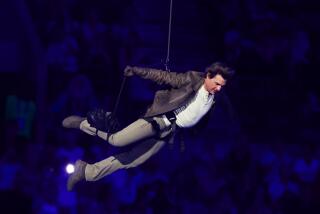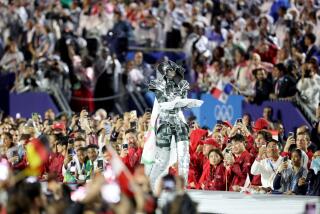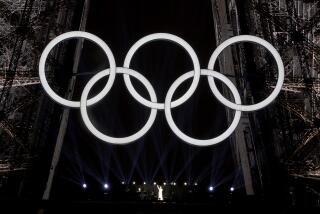Culture : Paris Unveils ‘New’ Champs Elysees : A $45-million face lift restores the old luster to the famed boulevard.
- Share via
PARIS — When the police swooped down on the Avenue des Champs Elysees five years ago, the magnificent artery that had catered to Paris high society, borne the remains of Napoleon, and thundered with the tanks of Nazi occupiers and Allied liberators was a sad sight indeed.
Hawkers ruled the narrow sidewalks, traffic clogged the side roads, neon lights flashed from the buildings, beggars mingled with the crowds and pickpockets roamed with abandon. The street was still a magnet for Parisians as well as foreigners. But, to many, greed and profit seemed to have supplanted taste and civility.
Within weeks, the police drove the hawkers away, confiscating everything from balloons and chestnuts to lithographs and soft drinks. And the street cleaning, as it turned out, was the beginning of a long climb back to respectability for the Parisian thoroughfare, which received its name 285 years ago.
Last week, after a $45-million face-lift, Paris Mayor Jacques Chirac dedicated the new look, saying the street had regained its prestige and, more importantly, reclaimed “the magical character which it had in the subconscious of the French and of foreigners.”
“We want to give the Champs Elysees the luster of old,” Chirac added.
To be sure, the rebuilding project, which works out to about $8,000 for each foot of the 1.1-mile-long avenue, has made the Champs Elysees more user-friendly.
Gone are the parallel access roads, paved over in gray, blue and white to form 60-foot wide sidewalks from the Rond-Point to the Arc de Triomphe. Those sidewalks, traversed by 200,000 people on weekdays and 300,000 on weekends, have been specially treated to make them resistant to oil stains and sticky chewing gum. And a new 850-space parking garage has been built underground.
A second row of plane trees, 227 of them, has been planted along the street, and strollers can park themselves on 51 new benches, made of dark tropical wood at a cost of $4,000 apiece. The bus shelters, telephone booths, newspaper kiosks and street lamps have been artfully redesigned, in cast iron, glass and stainless steel.
“It is just extraordinary,” said Maurice Casanova, the owner of Fouquet’s, the last remaining Belle Epoque-style restaurant on the avenue. “It’s remarkable what has been accomplished. There are large pavements with no cars. There is space again for the people.”
At the Lido, where mostly foreign customers take in the cabaret reviews while guzzling 800 bottles of Champagne a night, spokesman Bernard Etienne gushed: “It’s fabulous. It’s going to attract more tourists, and this will restore our international reputation. The Champs Elysees is again the show window of Paris.”
Not everyone is pleased with the overhaul, of course. This is Paris, after all, where changes in the city scape are hotly debated among everyone from the bricklayers to the intellectuals.
Some strollers complain about the lack of flowers, for example. Other critics think the architectural styles clash. And still others say a country with more than 3 million people out of work could find better ways to spend so much tax money.
Le Monde, the daily newspaper of intellectuals, welcomed the broad pedestrian walkways, “which recall the avenue’s original role as a promenade.” But it contends that the project is “distorted” by an attempt to please all tastes. Modern benches and replicas of Old Paris street lamps, for example, create a jarring mix, it says.
“Not to choose was the worst choice of all,” Le Monde said. “Each style is canceled out in a visual jumble.”
Even supporters of the project agree that there is still more to do.
The root of the Champs Elysees’ problem is not the sidewalks or the street itself, but rather the shops and businesses that have sprung up along it in the last two decades. In the 1960s, Gen. Charles de Gaulle described the street satirically as “the most beautiful avenue in the world, if you disregard the buildings that line it.”
Long gone are the grand hotels, the haute couture shops and fancy restaurants that gave the street its special character in the 19th Century and well into this century. Gone too are the graceful townhomes and many of the cafes where Marcel Proust and others used to hang out.
They have been gutted for chrome-and-glass shopping malls, video-game arcades, automobile show windows, and fast-food restaurants, including a Burger King and a 400-seat McDonald’s restaurant.
Now there is a new, two-story branch of the Disney Store and a three-story Virgin Megastore. The street is also lined with no fewer than 55 banks and 46 movie screens, which advertise mostly American films.
High society no longer promenades on the Champs Elysees, and the smart set of young French professionals, the type of people who read Le Monde, avoid it as well. They’ve been replaced by camera-lugging tourists; les dragueurs , young men and women from the working-class suburbs on the prowl for each other and Monsieur Tout le Monde , Mr. Everyman. Hundreds of thousands of ordinary people.
While it may no longer be a chic avenue, Napoleon’s “triumphal way” has become a people’s avenue. What the street has lost in aristocracy, it has gained, tenfold, in democracy.
Driving away the street peddlers, adding police patrols to curtail petty crime and widening the pedestrian walkways has transformed “the boulevard of the unwashed and tasteless,” as Time magazine once described it, and paved the way for even greater changes, in the view of some merchants.
“This has been the first big step in the right direction,” said Casanova of Fouquet’s. “And I think the rest will follow. Shop owners will realize that they don’t have the right to denature the beauty of what has been done.”
The urge to turn the Champs Elysees into a museum is understandable, given its rich heritage. It begins at the Place de la Concorde, where the 3,300-year-old obelisk from the Temple of Luxor was installed 1 1/2 centuries ago, and continues to the 162-foot-tall Arc de Triomphe, commissioned by Napoleon in 1806 to honor his soldiers.
Being 200 feet wide, and flanked by buildings under the 79-foot Paris height limit, the Champs Elysees is tailor-made for parades. In 1840, Napoleon’s casket was pulled along the avenue by a single white horse. And Allied troops marched there to celebrate the end of World Wars I and II.
It has also been an emotional center of the city, a magnet in times of crisis and celebration.
The area was only fields and marshlands in the early 17th Century when Marie de Medici, wife of King Henry IV, turned it into a royal, tree-lined carriage path. In 1706, the shaded avenue was named the Champs Elysees, which means Elysian Fields, a reference, from ancient Greece, to the place at the end of the earth where those favored by the gods can find perfect happiness.
A succession of kings improved the route, which was notoriously dusty, and, in 1807, Napoleon invited 10,000 men for a feast at tables arranged there. It was under Emperor Napoleon III, in the mid-19th Century, that the avenue blossomed, becoming a key part of the cityscape envisioned by the renowned urban planner, Baron Georges Eugene Haussmann.
From the 1800s into the early part of this century, the avenue drew the fanciest shops and was a showcase of mansions. Arriving in horse-drawn carriages, elegant Parisians stopped to listen to cafe orchestras and danced to polkas in the streets. But the avenue’s commercial success in the 20th Century also became, in a way, responsible for the changes that are now lamented.
In the 1970s and early 1980s, many of the French owners of the avenue’s buildings sold out to foreign businesses. Today it is estimated that more than 60% of the structures are owned by foreigners from the oil-rich Persian Gulf, the United States and Japan.
The genesis of the street’s latest make-over was a threat to evict Fouquet’s, made by the profit-minded absentee Kuwaiti owners of the building that houses the restaurant.
The restaurant’s owner, Casanova, gathered supporters from his famous clientele, and the government’s minister of culture responded to their pleas by declaring the restaurant a national monument part of the French heritage that must be protected in perpetuity.
These days, the avenue has been completely turned over to the people, French and foreign, who take pleasure in its natural grandeur and also its new international and commercial soul.
“The Champs Elysees,” Mayor Chirac said, “is a prestigious and necessary address for foreign companies. But it is also still an exceptional showcase for French savoir-faire.”
More to Read
Sign up for Essential California
The most important California stories and recommendations in your inbox every morning.
You may occasionally receive promotional content from the Los Angeles Times.











